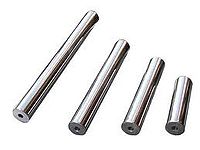Difference between revisions of "Magnetic Rods"
Jump to navigation
Jump to search
(Created page with "Category:Magnetic Seperating{{Knoppen}} <noinclude><!------------------------------------------------ * READ THIS FIRST * Only edit this page if you can improve the content...") |
|||
| (One intermediate revision by one other user not shown) | |||
| Line 1: | Line 1: | ||
[[Category:Magnetic | [[Category:Magnetic Separating]]{{Knoppen}} | ||
<noinclude><!------------------------------------------------ | <noinclude><!------------------------------------------------ | ||
* READ THIS FIRST | * READ THIS FIRST | ||
| Line 7: | Line 7: | ||
* Please start editing this page after the /noinclude | * Please start editing this page after the /noinclude | ||
* -------------------------------------------------></noinclude> | * -------------------------------------------------></noinclude> | ||
[[File:Magnetic Rods_1.jpg|thumb|200px|right|Magnetic Rods]] | |||
'''Magnetic Rods''' are cylindrical magnets which have a length at least as long as their diameter. These magnets can have very strong flux output and are stable at high temperatures. | |||
==Features== | |||
*Temperature stability in high temperature applications, and a maximum working temperature of approximately 1000°F | |||
*The rod magnets may be ground to size but not by conventional machining. We can grind them to your specifications. | |||
*The rod magnets have high residual induction and energy product compared to ceramic magnets, and low coercive force compared to ceramic and rare earth materials (more subject to demagnetization). | |||
==Video== | |||
<youtube>n6XXroLojio</youtube> | |||
Latest revision as of 23:53, 27 April 2013
Magnetic Rods are cylindrical magnets which have a length at least as long as their diameter. These magnets can have very strong flux output and are stable at high temperatures.
Features
- Temperature stability in high temperature applications, and a maximum working temperature of approximately 1000°F
- The rod magnets may be ground to size but not by conventional machining. We can grind them to your specifications.
- The rod magnets have high residual induction and energy product compared to ceramic magnets, and low coercive force compared to ceramic and rare earth materials (more subject to demagnetization).
Video
